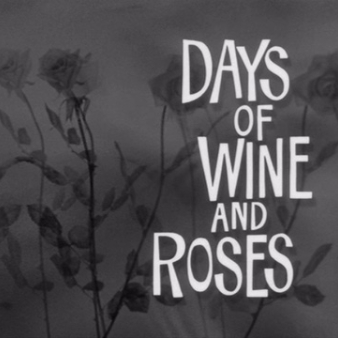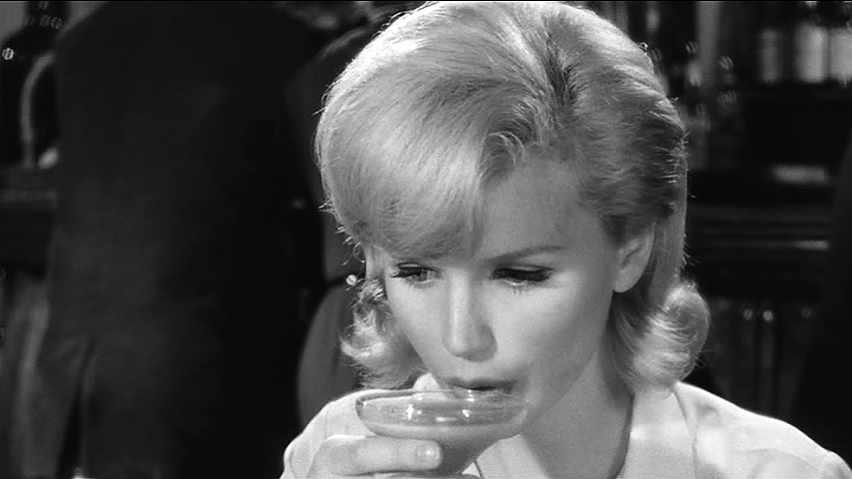DAYS OF WINE AND ROSES:
THE TELEVISION PLAY (1958) VS.
THE FILM (1962)
As I look at how the 1962 film version of Days of Wine and Roses compares and contrasts to the 1958 Playhouse 90 version, I find that this time, it was almost like looking at two different stories under the same title. Unlike past teleplay to film productions, Days of Wine and Roses the film did not have any of the major players from the teleplay involved save for its writer (J.P. Miller) and one actor (Charles Bickford). It should be noted that Bickford was billed as a 'guest star' in the television version, so why he was chosen to recreate his performance in the film while the main actors in the television play (Cliff Robertson and Piper Laurie) were passed over makes things more curious.
It makes sense in that Jack Lemmon and Lee Remick were probably bigger names than Robertson and Laurie, who achieved greater fame shortly after the film version of Days of Wine and Roses was released. Both Lemmon and Remick received Academy Award nominations for their work in the film version, so that should say something in their favor I suppose.
Still, this is a very curious scenario in these teleplay to film comparisons in that Miller was the only aspect connecting both productions, and like Rod Serling with Requiem for a Heavyweight, had to expand his work. However, while Serling at least stayed close to what he wrote for Playhouse 90 in the film version, Miller and director Blake Edwards essentially created a whole new version of Days of Wine and Roses.
Structurally, they are different. Character-wise, they are different. It almost was a whole radically different version. Part of it was due to having to make an 80 minute teleplay into a 117 minute feature film. That's nearly a half-hour of padding, and in retrospect perhaps it was a mistake to make the film version that long, as a 90 minute film adaptation could have worked just as well.
Later on, I'll take a look at the differences between the Playhouse 90 version and the 1962 theatrical version of Days of Wine and Roses, but for now, let's get the comparisons going.
BEST JOE CLAY
Cliff Robertson
Jack Lemmon
I don't dislike Jack Lemmon, but somehow what I saw out of his performance in Days of Wine and Roses felt like he thought it was a comedy, with him doing a variation of his C.C. Baxter in The Apartment. There are particularly bad moments, such as his 'striptease' which again relied too much on broad physical comedy than on a more playful tone. This is a man who is apparently delighting at the thought of boozing it up again after being sober for a few weeks or months. Lemmon does it with the same mannerisms that he had when playing the maracas in Some Like It Hot.
Robertson, on the other hand, played Joe like an average man, not a clown. In this same 'striptease' scene, his dance is one of anticipation, not farce. Robertson made his slide into full-blown alcoholism real and tragic. Lemmon plays Joe as if he already were a functioning alcoholic, and a comic one at that.
Part of it is the screenplay, though again it was P.J. Miller adapting his own work. I suspect Lemmon and director Blake Edwards had a hand in pushing for a more comic take on things, much to the film's detriment. There's a scene in 1962 where Lemmon's Joe, already sloshed, comes home with flowers, only he doesn't realize the flowers got caught in the elevator door, leaving just the stems. This is meant for laughs, but the tone of Days of Wine and Roses is meant to be more serious, not silly.
I think the best and worst comparison is in the Greenhouse scene. Here, Joe has hidden a bottle of alcohol in the fifth row, third table, fourth pot. Why he made it so complicated when he could have gone fourth row, fourth table, fourth pot or something like that I cannot say. With Robertson, his reaction at not finding it is one of desperation and anger. With Lemmon, his reaction is of unhinged hysteria. Robertson seemed like a genuinely angry drunk man. Lemmon seemed like he'd just gone bonkers.
BEST KIRSTEN ARMESEN
Piper Laurie
Lee Remick
It is a bit unfair to compare Laurie and Remick only in that they appear to be playing two different characters. Again, this is a result of the screenplay. In 1958, Kirsten was already quite familiar with drinking. In 1962, Kirsten seems almost virginal to it. Therein lies the difficulty. In one version, Kirsten was if not already an alcoholic at least one who did drink. In the other, she did not drink at all and was seduced into it.
Given that, why am I giving the edge to Remick over Laurie, even though both gave excellent performances? I think it has to do with the fact that Remick looked more disheveled when she turned into a drunken slut than Laurie did. Well, at least as any star can look disheveled, as Remick still managed a touch of glamour even at her worst. Laurie made her Kirsten a figure of pity and sorrow. Remick made hers a figure of tragedy and horror.
With Remick, her interpretation of Kirsten is more tragic because she felt almost forced into drinking at first, only to find herself more enthusiastic to it. With Laurie, her interpretation of Kirsten is slightly less tragic because she was already on the sauce when we first meet her. Thus, her fall is shorter. No less sad, but still not so overwhelming.
BEST DIRECTOR
John Frankenheimer
Blake Edwards
There is no excuse for not allowing Frankenheimer to direct the film version of Days of Wine and Roses. According to Frankeheimer, he was not given the chance to direct the film version of the teleplay that he had directed because Jack Lemmon thought Frankenheimer could not direct comedy. Twenty-odd years later, Frankenheimer was still incredulous at this reasons. "I never saw it as a comedy," he remarked, amazed at this rationale.
I'm with Frankenheimer on this, because Days of Wine and Roses is not a comedy. It's a very tough drama on a very tough subject, and while there can be light moments in a drama, even funny ones, the idea that Days of Wine and Roses is a comedy is downright nuts. Granted, Lemmon was right in his appraisal of Frankenheimer: there is in 1958 a 'comical' drunk at the AA meeting who fails constantly to be funny and proves more distracting. That, however, is a minor detail.
Perhaps the idea that Days of Wine and Roses is a comedy or even a rom-com is what makes 1962 in my mind terribly weak. It has overtly funny moments, such as Lemmon making a face to Remick behind her back, that are not funny. Worse, some of the moments that are meant to be extremely dramatic come across as unintentionally hilarious, such as when Lemmon is thrown into the psycho ward.
This scene is in both versions, but Frankenheimer used shadows and light to great effect, and he also pushed Robertson down in his performance, grounding him in fear and confusion but not raving hysteria. That is something Edwards could not do with Lemmon, who was devouring the scenery as if he had never eaten before in his life. I found myself laughing at Lemmon when he was locked up in the loony bin, twice if memory serves correct, and when he is rampaging through the greenhouse. Frankenheimer made the stay at the psych ward almost scary, whereas Edwards made it look hysterical.
I guess under Edwards, Days of Wine and Roses was a comedy, though not in the way they planned.
BEST VERSION
1958
1962
I know many critics hold the film version of Days of Wine and Roses to be a brilliant film, but I found it the Alcoholic Version of Reefer Madness, trying to warn me against the dangers of drink but making it look so outlandish that it made drinking look fun.
For all the mockery Reefer Madness gets, with reason even though I have never inhaled or exhaled myself, I do not understand why 1962 does not get the same mockery. If I am to believe Days of Wine and Roses, a drink will lead a former teetotaler to become a sex-crazed floozy who all but begs her own father for a romp. Alcohol, according to Days of Wine and Roses, will lead to incest, attempted robbery and insanity, all things that occur in the film.
There is almost a sensationalist bent to 1962, and I think it has to do with how the material is handled. I admit to having a touch of prejudice in this matter, since I have seen people drunk and have known serious alcoholics. What has happened to them, however, was not storming into their parents' bedroom demanding 'a kiss', rampaging through greenhouses or being tied up in straight-jackets. It's been incoherence, cirrhosis of the liver, and other health issues like obesity and diabetes. None of the alcoholics I've known have been as crazed as Joe and Kirsten Clay.
The 1958 version was more grounded in reality. When Joe falls off the wagon because his wife seduced him back into it, he was in a hospital. In the 1962 version, when Joe falls off the wagon because his wife seduced him back into it, he tries to steal from a liquor store and has to be tied down to a bed in what appears to be his second visit to an insane asylum.
1958 also is shorter and thus has little padding. 1962 has endless stretches of 'comedy' that don't work or could have been removed. I suspect those were added to tailor the film to Lemmon's comedic style, but I did not think it was funny.
I also think we have to see that 1958 is different than 1962 in terms of story and setting. 1958 is set in New York where both characters drink, and their joint boozing brings out the worst in each other. It also tells its story in extended flashbacks, with Joe's AA meeting taking place in the present.
1962, however, starts us in San Francisco, with a Joe who is already a functioning alcoholic, with Kirsten being almost completely unfamiliar with drink and the AA story set further down the road. It's more chronological but it skimps on things. We learn in both for example that Kirsten wants to get an education through a book series. In 1958, the loss of her books to get more booze is tragic. In 1962, it's only hinted at, with no sign of the tragedy that the loss of those books are to her character.
I think we can see how different they are with the music. The 1958 version has a rather intense jazz score, punctuating the tragedy and horror of their slide into the bottle. The 1962 version has the lush theme song (no pun intended), a very sad and romantic number. Days of Wine and Roses is a beautiful number, though again I wonder why so many good singers, like Frank Sinatra and Ella Fitzgerald, sing it in an upbeat tempo, as if this song celebrated something wonderful rather than something tragic.
With a shorter running time, tighter performances, a stronger story structure and sharp directing, the 1958 version of Days of Wine and Roses outdoes the in my view overpraised 1962 version.




No comments:
Post a Comment
Views are always welcome, but I would ask that no vulgarity be used. Any posts that contain foul language or are bigoted in any way will not be posted.
Thank you.